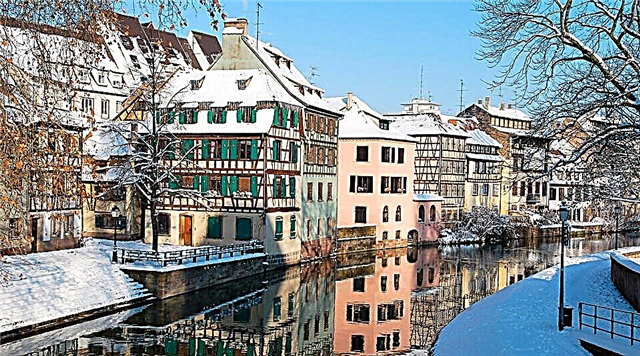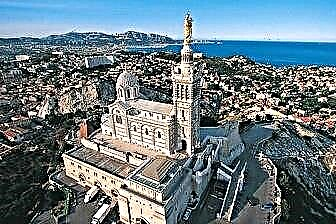Marseille is the oldest Mediterranean harbor, a city with a rich, centuries-old history. It has existed for over 2.5 thousand years. The old city port has been an important hub for international trade since Antiquity. The powerful forts of Marseille were built by Louis XIV, better known as the "Sun King," and the graceful Baroque palaces were the legacy of the last French emperors.
Holidays in Marseille are designed for a wide range of tourists. There are enough attractions for a rich excursion program, and the magnificent beaches of the Friuli Islands will appeal to everyone. Tourists who prefer an active lifestyle can explore on foot the coast in the vicinity of Marseille, dotted with beautiful bays - calanques.

The best hotels and hotels at affordable prices.
from 500 rubles / day
What to see and where to go in Marseille?
The most interesting and beautiful places for walking. Photos and a short description.
Old port of Marseille
The history of Marseille began from the Old Port. It was here that the Phocian Greeks landed 600 BC and founded a colony. Since the 13th century, a shipyard operated in the port, where warships were built. Until the 19th century and the construction of the New Port, the marina served as the sea gate of Marseille. Nowadays, the Old Port has been chosen by yachtsmen and seafood sellers, turning it into a popular tourist center.

Longchamp Palace
The palace was erected in the 19th century, the first stone in its foundation was laid by the Duke of Orleans. Longchamp is a whole architectural complex, which includes a sculptural group of a fountain, a facade in the form of a triumphal arch and symmetrical colonnades. On the territory of the palace there is the Museum of Natural History with an extensive collection of natural sciences and the Museum of Fine Arts, which exhibits sculpture and painting of the 16th - 19th centuries.

Chateau d'If
The famous fortress of the 16th century, which was immortalized in his works by A. Dumas. It was in the prison of the Chateau d'If that Edmond Dantes from the novel The Count of Monte Cristo languished. Initially, the fort served to protect Marseilles from attack from the sea, but very soon it became a prison. From 1580 to 1880 the gloomy fortress on the island of the same name was considered the most terrible dungeon in Europe. 10 years after its closure in 1890, the Chateau d'If became available to tourists.

Faro Palace
The palace was built in the 19th century by order of Napoleon III for his wife, now the building belongs to the city authorities and is used for holding public events, conferences and receptions. The Faro Palace has about 500 rooms decorated in the Empire style. The building stands on a site near the sea, below there are cliffs and a steep coast. The best panoramic view of the castle is from the water.

City hall
The building of the city council was erected in the middle of the 17th century. In turbulent times of endless revolutions, he miraculously managed to avoid demolition, although such thoughts periodically occurred in the newly formed governments. The building was built in the Provencal Baroque architectural style according to the project of J.-B. Meolana and E. Belondel. The main entrance to the town hall is decorated with a bust of Louis XIV and the coat of arms of the Bourbon dynasty.

Marseille Exchange
An architectural monument of the 19th century, erected for the city Chamber of Commerce. The large hall of the exchange can accommodate up to 2.5 thousand people. Here are not only brokerage firms engaged in trading, there are also cultural institutions and a shopping center on the territory. The imposing stock exchange building looks monumental and somewhat cumbersome; its facades are entwined with a number of powerful Corinthian columns.

Fort Saint-Jean
Fortress built in 1660, erected under Louis XIV. The fort is the "gateway" to the Old Port of Marseille. It was erected after the city revolt against the rule of the governor of Provence. It is interesting that the guns of the fort were directed not towards the sea - towards the alleged enemy, but into the city. After the victory of the French Revolution, a prison was placed on the territory of the fortress, where many noble prisoners visited.

Fort Saint-Nicolas
Fortress located opposite Fort Saint-Jean. It was erected on the site of an ancient 13th century church designed by L. de Clairville. Saint-Nicolas was built with the same purpose as Saint-Jean - to suppress the repeated uprising of the townspeople and to intimidate the disaffected, although it was officially announced that the fortress would reliably protect Marseilles from enemies. The citadel was built in 4 years, which is considered a record time for the 17th century.

Abbey of Saint-Victor
The abbey was founded by the Monk Cassian at the beginning of the 5th century, on the site of the grave of Victor of Marseilles, a martyr and Christian saint. In the 9th century, as a result of the attacks of the nomadic Saracens, the monastery complex was partially destroyed, but in the 10th century it was restored. Until the 18th century, the abbey functioned successfully, but as a result of the widespread devastation of monasteries (a consequence of the French Revolution), the monastery fell into decay. Since 1840 it has been considered a national monument, but restoration was carried out only in 1963.

Basilica of Notre Dame de la Garde
The temple is located on a hill at the highest point of Marseille. It was erected in the middle of the 19th century on the foundations of an old fortress. The inhabitants of Marseille consider the basilica to be the patroness of the city. The building was built in the neo-Byzantine style according to the project of A.-J. Esperandier. At the top of the church bell tower there is an 11-meter statue of the Virgin Mary. Notre Dame de la Garde is one of the most visited tourist sites in Marseille.

Cathedral of Marseille
A picturesque cathedral, built during the period of the highest economic power of Marseille - in the second half of the 19th century. The temple was erected in a luxurious Byzantine manner with round domes and graceful balustrades. A wide variety of materials were used in the construction - from Italian marble to African onyx. The interior of the cathedral is lavishly decorated with mosaics, frescoes and bronze decorative elements.

Museum of European and Mediterranean Civilizations
The museum opened in 2013 when Marseille was selected as the European Capital of Culture. The modern building that houses the collections is connected to Fort Saint-Jean by a bridge. The museum exhibits both traditional items: paintings, coins, equipment, furniture, documents, and more provocative ones. Controversial exhibits include a picture of a "pregnant" man and a 1966 glitter and aluminum statue of Aphrodite.

Center de la Vieille Charite
A cultural center housed in a 17th century building. Previously, it housed an almshouse and a hospice. Nowadays, there are two museums in the center. One exposition is devoted to the culture of the countries of America, Oceania and Africa, the second is an archaeological collection. The building of the Center de la Vieille Charite is made in the Baroque style. The main material for the façade is pink and white stone from a local quarry.

Le Corbusier House of Marseilles
The 1952 house, designed by Le Corbusier, an architect who, after the end of World War II, implemented urban programs for the construction of residential buildings. This was an innovative plan for the middle of the 20th century, as the house consisted of 17 floors and could accommodate 1600 people inside. A gym, swimming pool, kindergarten and other public premises were located on the roof of the building.

Ruins garden
An area of archaeological excavations, which houses the remains of architectural structures, erected before our era. These ruins were discovered in 1967. They became direct evidence that a settlement arose here at the turn of the 6th-7th centuries BC. e. In order to preserve the priceless finds, it was decided to create a park, which was named "The Garden of Ruins".

Boreli Park
The park is located on a vast territory of 17 hectares. It has an English garden, a botanical garden, sculptures, fountains, "living" tunnels of flowers and other elements of French landscape design. In the middle of the park there is an 18th century castle that belonged to L.-J. Boreli - to the industrialist and ship owner. In the 19th century, the city authorities established a public park on the site of the former Boreli manor.

Velodrome Stadium
Sports arena for 67 thousand people. The last renovation was carried out in 2016 before the Euro 2016 championship. During the 20th century, the Velodrome hosted European league games, as well as individual matches of the world championships. The stadium was built in 1937 and has been the home arena for the Marseille Olympic football team for several decades.

Prado beaches
A complex of artificial beaches, which was created by the city authorities in the 70s. XX century. Before that, Marseille did not have its own beach. The embankment was made from small fragments of rock left after the construction of subway stations. The result is a coastal strip of about 3.5 km. in length, where, in addition to the beaches with all the infrastructure, there are playgrounds, parks and recreation areas.

Friuli islands
The Friulian archipelago consists of the islands of Tibulen, Ratonno and Pomegu. From the Old Port of Marseille, a city ferry leaves there every hour. The islands are attractive because there are a large number of comfortable beaches. Yachts are often moored in cozy coves, as people prefer to swim here, rather than in the artificial harbor of Marseille. Also on the islands there is a small settlement of Port Friul, where you can dine in a restaurant.

Calanques
Calanques are small picturesque bays, French "fjords", which are located on the coast from Marseille to Lea Ciot and Cassis. There are three ways to see this miracle of nature - during a sea cruise, a trip by car and a walk. Especially for hikers, the entire 20-kilometer coastline from Marseille to Cassis is equipped with hiking trails. Some calanques end with cozy sandy beaches.












